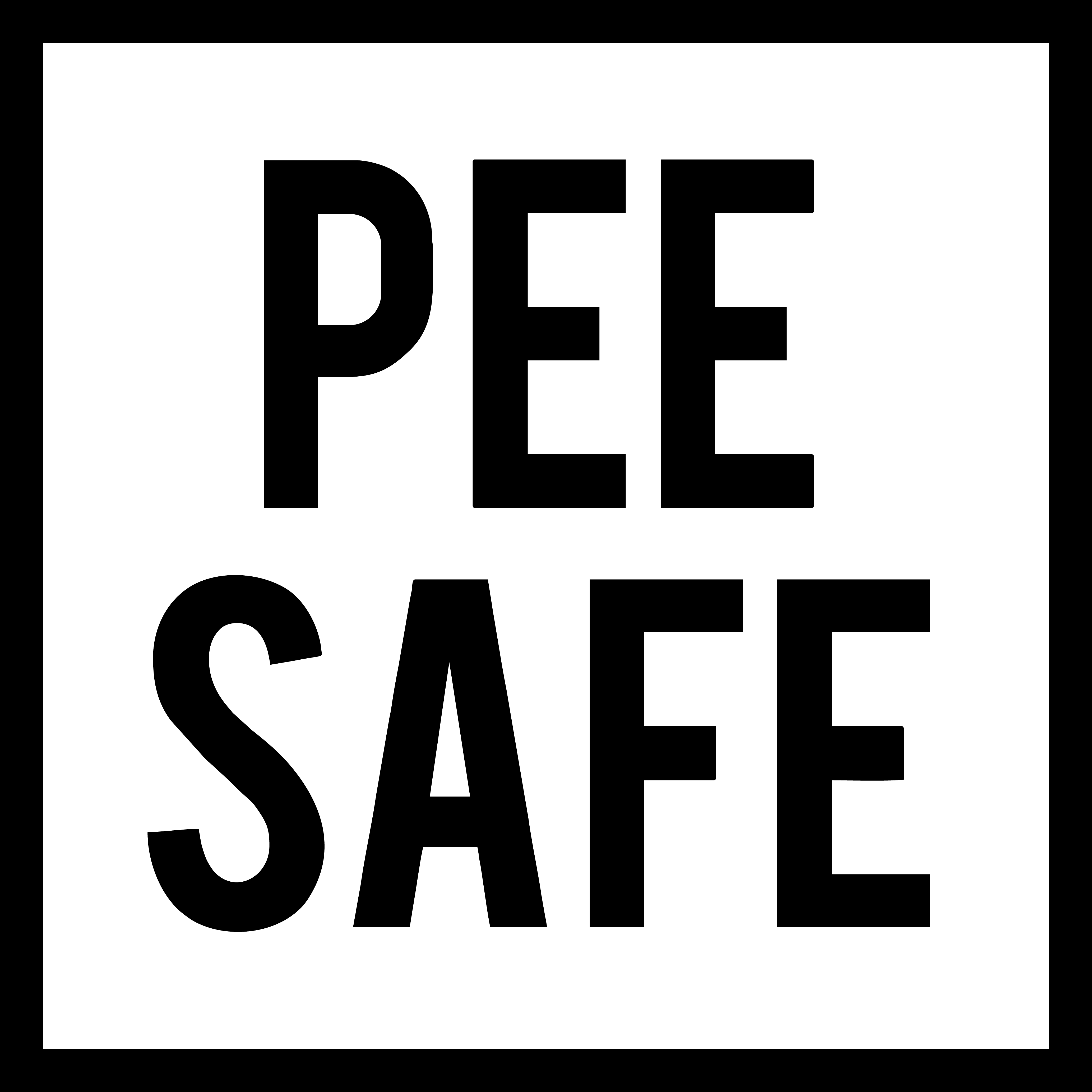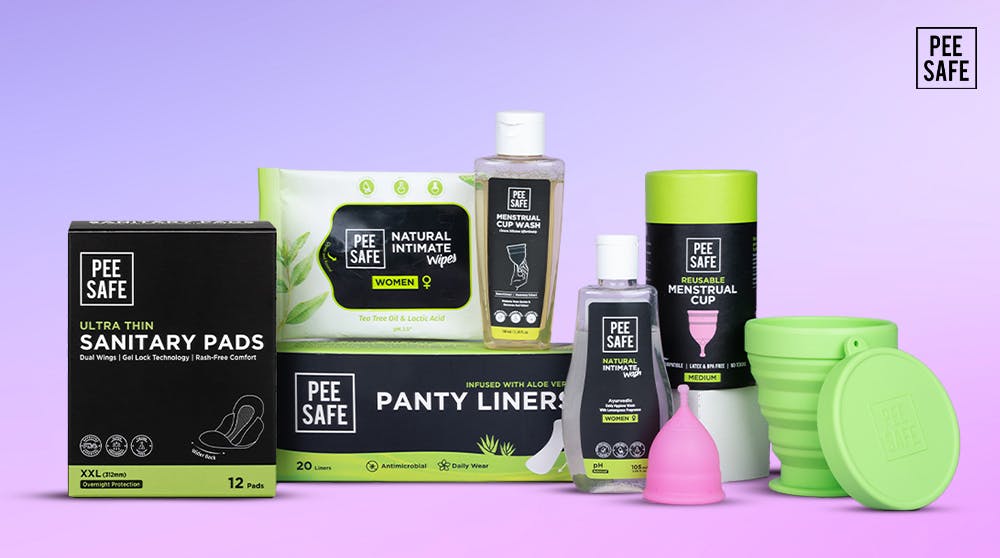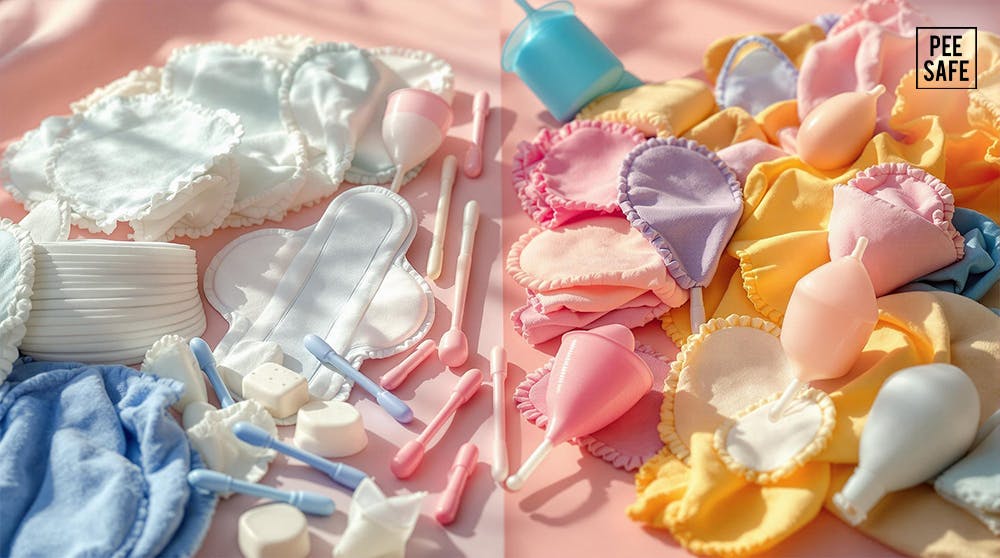Maintaining proper hygiene during your period is essential for staying healthy and comfortable. Here’s a quick guide to the key practices:
- Choose the Right Products: Use hypoallergenic pads, tampons, or reusable options like menstrual cups.
- Change Regularly: Switch products every 4-6 hours (or more often for heavy flow).
- Dispose Properly: Wrap used products and never flush them.
- Clean Gently: Wash the external genital area with warm water and unscented soap.
- Wear Breathable Underwear: Opt for cotton or period underwear to reduce moisture.
- Wash Hands Often: Before and after handling menstrual products.
- Sterilize Reusable Items: Clean menstrual cups thoroughly after each cycle.
- Take Daily Showers: Use mild soap and warm water to stay fresh.
- Care for Period Underwear: Rinse, wash gently, and avoid harsh chemicals.
- Monitor Your Health: Seek medical advice for unusual symptoms like severe cramps or heavy bleeding.
Quick Comparison: Menstrual Products
| Product Type | Usage Duration | Environmental Impact | Maintenance Needs |
|---|---|---|---|
| Disposable Pads | 4-6 hours | High | Single-use, discard |
| Tampons | 4-8 hours | High | Single-use, discard |
| Menstrual Cups | Up to 12 hours | Low | Regular sterilization |
Period Health & Hygiene Tips Every Girl Needs To Know
1. Select Suitable Menstrual Products
Picking the right menstrual products is essential for staying comfortable and maintaining hygiene during your period. The main options include disposable pads, tampons, and reusable products like menstrual cups.
Disposable Products
Pads and tampons are convenient and widely available. Look for hypoallergenic and fragrance-free options to reduce the risk of skin irritation [2].
Reusable Alternatives
Menstrual cups, typically made from medical-grade silicone, can be reused for years if properly cleaned and sterilized. They minimize waste and provide extended wear time when cared for correctly [2].
Here's a quick comparison of menstrual products based on usage, environmental impact, and upkeep:
| Product Type | Duration of Use | Environmental Impact | Maintenance Needs |
|---|---|---|---|
| Disposable Pads | 4-6 hours | High - Takes hundreds of years to decompose | Single-use; discard after use |
| Tampons | 4-8 hours | High - Can contribute to water pollution | Single-use; discard after use |
| Menstrual Cups | Up to 12 hours | Low - Reusable for years | Requires regular sterilization |
Match Your Lifestyle
If you're always on the go or love staying active, tampons or menstrual cups are great for discreet, long-lasting protection. For nights or heavy flow days, menstrual cups or overnight pads provide reliable coverage.
Eco-Friendly Options
Biodegradable products are a middle ground between disposables and reusables. They offer comfort while reducing waste, making them a practical choice.
Keep in mind that everyone's needs are different. It’s perfectly fine to switch between products during your cycle based on your flow and daily activities [2].
No matter what you choose, changing your product regularly is crucial to staying clean and avoiding irritation.
2. Change Menstrual Products Frequently
Changing your menstrual products regularly is key to preventing bacteria buildup and staying hygienic during your period. Nicole Ward, APN at Inspira Medical Group, emphasizes the importance of this practice [1].
Here’s a quick guide for how often to change different menstrual products based on your flow:
| Product Type | Regular Flow | Heavy Flow |
|---|---|---|
| Tampons | Every 4-6 hours | Every 2-4 hours |
| Pads | Every 4-6 hours | Every 2-4 hours |
| Menstrual Cups | Every 12 hours | Every 4-6 hours |
Important Tip: Never leave tampons or pads on for more than 8 hours, and menstrual cups should only be worn for up to 12 hours under normal conditions [1][3].
Tips for Staying on Schedule
- Set reminders on your phone.
- Use a period tracking app to monitor your flow and timing.
- Keep extras in convenient spots like your bag, car, or workplace.
Managing Heavy Flow and Recognizing Issues
For heavier days, switch to super-absorbent options and change them more often to avoid leaks or discomfort. If you notice any unusual odors or irritation, replace your product right away to help prevent infections, including TSS (Toxic Shock Syndrome) [1][3].
When You’re On the Go
Traveling or working during your period? Be prepared by packing extra supplies in a sealed container, carrying travel-sized wet wipes for quick cleanups, planning bathroom stops, and bringing disposal bags for used items.
3. Dispose of Menstrual Products Correctly
Handling menstrual products properly is important for maintaining hygiene and reducing waste. Here’s how to manage different types of menstrual waste safely.
Wrapping and Disposal Guidelines
Wrap used products in their original packaging, toilet paper, or biodegradable bags to contain any mess and prevent contamination.
Product-Specific Disposal Methods
| Product Type | Disposal Method | Notes |
|---|---|---|
| Pads | Wrap and place in bin | Never flush; they can take centuries to break down. |
| Tampons | Wrap and place in bin | Flushing can cause plumbing problems. |
| Menstrual Cups | Empty into toilet, clean | Wash thoroughly before reuse. |
| Period Underwear | Rinse and wash | Follow the care instructions provided. |
When You’re Out and About
When you're not at home, keep a few biodegradable disposal bags in your bag. Look for sanitary bins in restrooms, and never flush menstrual products in public toilets.
Reducing Environmental Impact
To minimize waste and its impact:
- Opt for biodegradable pads or tampons.
- Try reusable solutions like menstrual cups or period underwear.
- Use facilities with proper waste disposal systems.
- Pick products with minimal or eco-friendly packaging.
Reporting Issues with Facilities
If you notice issues like overflowing bins or missing disposal containers, let the facility management know. This helps maintain cleanliness and ensures proper waste management [2][4].
Improper disposal can clog pipes and harm water systems. Alongside responsible disposal, maintaining good personal hygiene during your period is key.
4. Clean the Genital Area Thoroughly
Proper hygiene during menstruation is key to avoiding infections and staying comfortable.
Gentle Cleaning Tips
Use warm water and a mild, unscented soap to clean the external genital area. Avoid internal cleaning or douching, as the vagina naturally cleans itself [1].
| Do's | Don'ts |
|---|---|
| Use lukewarm water | Use scented products or deodorants |
| Clean from front to back | Use harsh soaps |
| Pat dry thoroughly | Douche |
| Change underwear daily | Clean internal areas |
Why pH Balance Matters
The vagina has a natural pH balance that helps ward off infections. Harsh products can upset this balance, leading to irritation or other problems. Stick to gentle methods that support your body’s natural defenses [1][3].
Quick Cleanups on the Go
When traveling, pack a small hygiene kit with unscented wipes, fresh underwear, and a towel for quick cleanups.
Signs You Shouldn’t Ignore
Be alert to these symptoms, which may need medical attention [1][3]:
- Persistent odor
- Burning or irritation
- Unusual discharge
The goal is to maintain health, not to create artificial cleanliness. Warm water and gentle cleaning are often all you need [5][6].
Hygiene doesn’t stop at cleaning - choosing the right underwear materials also plays a role in staying healthy.
5. Use Breathable Underwear
Picking the right underwear during your period is key to staying comfortable and maintaining good hygiene. Natural fabrics allow better airflow and help reduce moisture buildup during menstruation [1][3].
Materials and Best Uses
| Material | Benefits | Best Use |
|---|---|---|
| Cotton | Allows airflow, absorbs well | Everyday wear, light flow |
| Bamboo | Resists bacteria, wicks moisture | Medium flow |
| Period Underwear | Built-in absorbent layers | Heavy flow days |
Care Tips
- Use unscented detergent to wash.
- Skip fabric softeners to keep materials breathable.
- Change your underwear daily - or more often if it feels damp [1][3].
Comfort and Extra Protection
For heavier flow days, period underwear with absorbent layers can offer added security without sacrificing comfort. These garments are designed to provide both protection and breathability during your cycle [1][3].
Things to Watch Out For
If you notice persistent dampness or discomfort, your underwear might not be breathable enough. Avoid synthetic fabrics like polyester and nylon, as they trap heat and moisture, which could lead to infections [2][6].
The type of underwear you wear has a direct impact on your menstrual hygiene and overall comfort. Choosing breathable fabrics and caring for them properly can make a big difference in your period experience while lowering the risk of health issues [6].
And remember - keeping your hands clean is just as important as wearing the right underwear to prevent infections during your period.
sbb-itb-3009f4a
6. Wash Hands Regularly
Keeping your hands clean is a key part of menstrual care. Experts highlight that proper handwashing can greatly reduce the risk of infections and complications during your period [1][3].
When to Wash
There are specific times when hand hygiene is especially important during your period: before changing menstrual products, after disposing of them, and after using the bathroom. Spend at least 20 seconds washing your hands each time.
| Timing | Why It Matters |
|---|---|
| Before changing products | Prevents bacteria from transferring to your body |
| After product disposal | Removes any contaminants from handling used products |
| After bathroom use | Maintains overall hygiene and reduces infection risks |
Proper Technique
Use soap and warm water to wash your hands thoroughly.
"Hand hygiene is the single most important measure to prevent healthcare-associated infections." - World Health Organization (WHO)
The World Health Organization highlights that proper handwashing can lower the risk of infections by up to 40-50% [2].
Practical Hand Hygiene Tips
If soap and water aren't available, an alcohol-based hand sanitizer can be a temporary solution. However, make it a priority to wash your hands with soap and water as soon as possible. Skipping or rushing through handwashing, especially during product changes, can increase the risk of infections. Nicole Ward, APN at Inspira Medical Group, stresses that thorough handwashing is essential for avoiding serious issues like toxic shock syndrome (TSS) [1].
You don’t need pricey antibacterial soaps - regular soap works just as well [1][3].
Good hand hygiene is crucial for your overall menstrual health, especially if you’re using reusable products like menstrual cups. Taking these simple steps can help keep you safe and comfortable.
7. Sterilize Menstrual Cups Properly
Reusable menstrual cups need the right care to stay safe and effective. Proper sterilization helps prevent bacterial growth and lowers the risk of infections [1][3].
How to Sterilize Your Menstrual Cup
Start by washing your cup with unscented soap and warm water. After that, sterilize it using one of these methods:
- Boiling: Place your cup in a pot of boiling water for 5-7 minutes. Make sure it doesn’t touch the bottom of the pot to avoid damage.
- UV Sterilizer: Follow the instructions provided with your device for safe and effective sterilization.
- Sterilizing Solution: Use a solution designed for menstrual cups and follow the directions carefully.
| Method | Duration | Tips for Best Results |
|---|---|---|
| Boiling | 5-7 minutes | Keep the cup off the pot's bottom. |
| UV Sterilizer | Varies by device | Follow the manufacturer's instructions. |
| Sterilizing Solution | As directed | Ensure the solution is cup-safe. |
Pre-Sterilization Cleaning
Before sterilizing, thoroughly clean the cup. Use unscented soap, rinse with warm water, and make sure to clear the suction holes to remove any residue [5].
Proper Storage
After sterilizing, store your cup in a breathable cotton pouch. This keeps it dry and clean while preventing moisture buildup between uses [1][3].
Signs Your Cup Needs Extra Cleaning
If you notice stains, odors, stickiness, or residue, it’s time for a deeper clean. Address these issues by washing and sterilizing the cup again before using it [1][3].
Taking these steps ensures your menstrual cup stays hygienic and ready for use. Pairing this care with clean period underwear enhances your overall comfort and hygiene during your cycle.
8. Maintain Period Underwear
Taking care of period underwear is essential for keeping them hygienic, extending their lifespan, and avoiding bacterial growth. Proper care ensures they remain effective and comfortable while reducing the risk of infections.
Washing Guidelines
Rinse period underwear with cold water as soon as possible after use. Use a detergent that protects the absorbent layers [1][3]. Steer clear of harsh chemicals that can harm the material:
| Avoid Using | Reason | Better Option |
|---|---|---|
| Fabric Softener | Reduces absorbency | Vinegar rinse |
| Bleach | Damages protective layers | Gentle stain remover |
| Hot Water | Sets stains | Cold or lukewarm water |
Drying and Storage
Air drying is best, but if you must use a dryer, stick to low heat. This helps preserve the moisture-wicking properties and keeps the underwear in good condition [1][3].
When to Replace Them
Keep an eye out for signs that your period underwear needs replacing:
- Fraying edges
- Loss of absorbency
- Lingering odors
- Damage to moisture-wicking layers
With proper care, period underwear typically lasts through 50-60 washes [2][4]. Replace them once they show signs of wear or reduced effectiveness.
Tips for Travel
Pack extra pairs and a waterproof bag for storing used items. Quick-dry options are ideal for hand-washing and drying overnight when you're on the go.
For heavy flow days, many people pair period underwear with other menstrual products for added protection. This combination helps maintain comfort and confidence throughout your cycle while ensuring reliable backup coverage.
Taking care of your period underwear is an important part of overall menstrual hygiene and helps them work effectively when you need them most.
9. Take Daily Showers
Daily showers play an important role in staying clean and healthy during your period.
Water Temperature and Products
Stick to warm water and a mild, unscented soap to clean the external genital area. Avoid hot water, strongly fragranced products, or rough scrubbers - they can irritate your skin.
| Product Type | Use | Avoid |
|---|---|---|
| Soap | Mild, unscented | Strongly fragranced |
| Water Temperature | Warm | Hot |
| Cleaning Tools | Soft washcloth | Rough scrubbers |
When to Shower More Often
You might need extra showers if you have a heavy flow, exercise, work in a hot environment, or frequently switch menstrual products.
How to Clean Properly
Gently wash the external genital area with warm water and mild soap, and pat the area dry to avoid moisture buildup. Skip internal cleaning - it can upset your vagina's natural pH balance and disrupt healthy bacteria [1][3].
Quick Alternatives
If you can’t take a shower, carry unscented cleansing wipes, a clean towel, fresh underwear, and hand sanitizer for quick touch-ups.
Good hygiene during your period isn’t just about staying clean - it helps prevent infections, reduces odor, and supports your overall well-being throughout your cycle [1][3].
10. Stay Informed and Seek Medical Help When Necessary
Being aware of your menstrual health and knowing when to reach out for medical advice plays a key role in maintaining both hygiene and overall well-being.
When to Contact a Healthcare Provider
Some symptoms shouldn't be ignored, as they may signal underlying issues that could affect your health:
- Severe cramps that disrupt daily life
- Heavy bleeding requiring frequent product changes (every 1-2 hours)
- Noticeable changes in cycle length or flow
- Unusual discharge, such as changes in color, smell, or texture
- Fever above 100.4°F (38°C) during menstruation [1][3]
Stay Informed and Track Your Cycle
Use reliable resources like WHO or UNFPA to stay updated on menstrual health. Keeping a record - through a period-tracking app or a journal - can help you monitor flow intensity, duration, and symptoms. This information can highlight patterns or irregularities that might need medical attention [2].
Regular Check-ups
Make it a habit to schedule yearly wellness visits to discuss:
- Changes in your cycle
- Hygiene habits
- Product options
- Any questions or concerns
If visiting in person isn’t an option, virtual consultations can provide quick advice or follow-ups [1][3].
Being proactive about your menstrual health helps you address potential issues early, supporting the hygiene tips mentioned earlier.
Conclusion
Maintaining good menstrual hygiene is key to preventing infections, staying comfortable, and feeling confident. These practices help support overall health during your period.
Taking care of menstrual products - whether they’re disposable or reusable - is essential. Simple steps like wearing breathable cotton underwear or setting reminders for product changes can make a real difference in menstrual health.
Eco-conscious choices also play a role. Using sustainable menstrual products helps cut down on waste while keeping hygiene standards high, balancing personal care with environmental awareness.
Key Tips for Menstrual Health
To stay healthy during your period, focus on these habits:
- Change menstrual products every 4-6 hours, or more often if needed.
- Wash your hands thoroughly before and after handling products.
- Take daily showers with mild, unscented soap.
- Dispose of products in a safe and hygienic way.
Building these habits protects both your health and the planet. If you experience unusual symptoms, consider consulting a healthcare professional, as recommended by Inspira Health specialists [1]. By following these steps, you can take charge of your menstrual health while contributing to a cleaner environment.



























